| Sunday, May 27, 2007 |  |
|
|
|

Wow, I wish it really were like that when I lived in Los Angeles. Would have made the city feel completely different. Here you find the bigger version. If you're not familar with L.A., it is not like that at all, it is an elaborate imaginary exercise. L.A. does have a subway, but for most people in the city, it isn't very relevant, because most people live nowhere near a station. I've never even taken a ride on it. I wanted to, I meant to, but strangely didn't get around to it, because there was nothing really useful I could do with it, and it would take a bit of travel to get to a station. Now, if it had been like on the map, I can right away see how I would have used it. For years I commuted from close to where that Verdugo Rd station would be to 7th street in downtown. Took about an hour to get home on the bumper to bumper freeway.
The funny thing is that Los Angeles used to have an electrical rail system very much like the imaginary one. Or, rather, that's not funny at all, it is rather tragic. Take a look at the Red Car line that existed in the early 1900s. You can read its story on Wikipedia. There were various reasons for its demise, including that it didn't work very well and was in need of serious modernization. But a greatly contributing factor was the well-known conspiracy between General Motors and Standard Oil, forming a company that bought up rail lines in order to shut them down and replace them with cars and busses.
(Via BoingBoing)
Now, looking at the current Mass Transit System for Los Angeles, I notice there are new developments since I moved. Like a fast bus line through San Fernando Valley where I lived. But the Map is still very unimpressive compared with cities that have a good mass transit system. Somehow it doesn't feel like a very relevant system. And, wow, while I lived in L.A. I was under the firm belief that there was a subway from downtown to Santa Monica along Wilshire, and I just realize that it never was finished. Strange. I clearly remember when they were working on it, and there's even been movies about it, and it doesn't even exist. Some polical maneuvering held up the funding for it and it was never completed.
[ History | 2007-05-27 01:49 | | PermaLink ] More >
|
|
| Sunday, March 11, 2007 |  |
|
|
|
Sides of Fidel Castro that maybe are little known. This Washington Post article talks about a collection of letters he wrote while in prison in the 50s, which hadn't appeared in English before. Which in part show spiritual depths one maybe wouldn't expect of a future communist dictator. Like, addressing the father of a fallen comrade, he writes:"I will not speak of him as if he were absent, he has not been and he will never be. These are not mere words of consolation. Only those of us who feel it truly and permanently in the depths of our souls can comprehend this. Physical life is ephemeral, it passes inexorably. . . . This truth should be taught to every human being -- that the immortal values of the spirit are above physical life. What sense does life have without these values? What then is it to live? Those who understand this and generously sacrifice their physical life for the sake of good and justice -- how can they die? God is the supreme idea of goodness and justice."
[ History | 2007-03-11 02:09 | | PermaLink ] More >
|
|
| Thursday, February 15, 2007 |  |
|
|
|
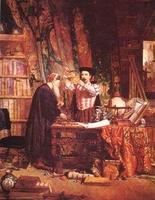 First, a little piece about patterns, which I noticed quite randomly in an article about Ancient Chinese Sex Advice: First, a little piece about patterns, which I noticed quite randomly in an article about Ancient Chinese Sex Advice:It is a commonplace that the Han dynasty distinctions between the 100 schools of philosophy are to some extent false divisions forced on a much more complex history. Lewis takes this further and tries to uncover what the categories of thought were in Han and pre-Han China. Part of this, particularly in Writing and Authority, is the importance of patterns. There are patterns that govern the changes in the universe, human affairs and the body, and understanding and adjusting and adjusting to these patterns is what knowledge is all about. (Lewis explains all this a lot better than I do.)
One aspect of this is the sage, the person who has learned to be a master of patterns. There are lots of different aspects of this, one of which is medicine. One’s body is of course governed by the same patterns as everything else and thus being a doctor, preserving one’s health and attaining immortality through alchemy and ruling the empire all involve the same sort of knowledge. Those with a proper knowledge of patterns can avoid all sorts of nasty things and can also draw power from the universe. That sort of spoke to me. In early times, wise people were those who had integrated all kinds of knowledge, who were skilled in reducing it to simple, universal patterns. And just that idea there, that we even can find patterns in the universe that apply equally well in health, politics, physics, or whatever.
Alchemy went out of fashion at some point. Physicists a few hundred years ago, like Newton, were invariably alchemists at the same time. They were kind of inseparable subjects. Da Vinci, he found it quite natural to master art, science and medicine at the same time. If we're looking for the patterns of the universe, it is only logical that we look for the common patterns in all of this. As opposed to separating out one aspect, trying to find the rules for that, and ignoring whether it fits on anything else.
It is the difference between holistic thinking, like we associate with Eastern medicine now, and the archetypical Western approach of cutting everything into little pieces and treating them separately. Where, interestingly, the Eastern approach would tend to deal with the exact, unique individual or situation, but as a whole, and the Western approach dissects the pieces, but then treats them in a generalized abstract way, preferably without variation.
So, how about alchemy. Wikipedia has a nice page on it: In the history of science, alchemy refers to both an early form of the investigation of nature and an early philosophical and spiritual discipline, both combining elements of chemistry, metallurgy, physics, medicine, astrology, semiotics, mysticism, spiritualism, and art all as parts of one greater force. Alchemy has been practiced in Mesopotamia, Ancient Egypt, Persia, India, and China, in Classical Greece and Rome, in Muslim civilization, and then in Europe up to the 19th century—in a complex network of schools and philosophical systems spanning at least 2500 years.
Western alchemy has always been closely connected with Hermeticism, a philosophical and spiritual system that traces its roots to Hermes Trismegistus, a syncretic Egyptian-Greek deity and legendary alchemist. These two disciplines influenced the birth of Rosicrucianism, an important esoteric movement of the seventeenth century. In the course of the early modern period, mainstream alchemy evolved into modern chemistry.
Today the discipline is of interest mainly to historians of science and philosophy, and for its mystic, esoteric, and artistic aspects. Nevertheless, alchemy was one of the main precursors of modern sciences, and many substances and processes of ancient alchemy continue to be the mainstay of modern chemical and metallurgical industries. But it doesn't really leave anything that's very applicable nowadays. Are there any alchemists in any meaningful sense nowadays? I mean people who're polymaths who search for the patterns in the universe in both scientific and metaphysical ways? There was Buckminster Fuller. But it is a bit of rare thing.
[ History | 2007-02-15 14:24 | | PermaLink ] More >
|
|
| Thursday, November 2, 2006 |  |
|
|
|
 CNN: CNN:PARIS, France (AP) -- An elderly couple waltzes to the steady carnival music of an organ grinder on the dingy platform of a Paris subway station. But it's nearly 3 a.m., and the station has been closed since World War II.
They are part of a traveling nocturnal party that barrels through the tunnels of the Metro long after the passenger trains have been tucked away for the night. These riders are on an exclusive, all-night Metro history tour, organized a dozen times a year by a group of railway buffs.
The ADEMAS association, dedicated to restoring old trains and preserving the Metro's history, has been around since 1992. (ADEMAS stands for Association D'Exploitation du Material Sprague; the Paris Metro's Sprague-Thomson model cars date to the early 1900s.)
But until recently, the group was as mysterious as the phantom stations they visit on their tours.
Rumors about the all-night Metro rides circulated by word of mouth and in Internet chat rooms, but details were almost impossible to track down -- until June, when ADEMAS launched its Web site. But even that lacks specific times and tour dates.
Association president Julian Pepinster says it's with good reason. There are just 2,400 spots available each year.
"There's a constant demand for the tours," he said in an interview. "Even with a dozen tours a year, there's always a six-month wait."... Cool. I wanna do that. More here or here.
[ History | 2006-11-02 17:44 | | PermaLink ] More >
|
|
| Thursday, December 2, 2004 |  |
|
|
|
As envisioned by the Rand Corporation 50 years ago. Yeah, they were pretty spot on. Except for I don't have that big steering wheel thing.
... Later: see comments. It is actually a fake photoshopped picture, pieced together from a submarine control panel and a few other items from other sources. But, hey, splendid work.
[ History | 2004-12-02 14:56 | | PermaLink ] More >

|
|
| Monday, November 15, 2004 |  |
|
|
|
 A little history lesson from Ben Hammersley: A little history lesson from Ben Hammersley:As solace, or a warning, I give you history from around five hundred and ten years ago, here in Florence. After the city had seen a period of intense financial growth and the blossoming of art, philosophy and literature - and a period of international influence and real financial power stretching from London to Jerusalem, which is about as far as a European could stretch in those days - a small, but vocal, minority started to talk about the sinfulness of the local society: the lax morals; the frivilous civilisation; the unchristian corruption of the leaders; their preference of idolatrous and, frankly, homoerotic art. It was, they said, time to get back to basics. To real Christian values.
Their leader, Girolamo Savonarola, preached hellfire and damnation and roused the crowds into rejecting the old ways. Groups were formed, going door to door to punish gamblers, drinkers, women dressed in too immodest clothing and other such outrages to their beliefs. Artworks, books, playing cards, ornaments, and all the other symbols and tools of the more liberal citizens were seized, and publicly burnt in the middle of the main square - the Bonfire of the Vanities.
The crowds, the less educated, the less worldly, loved all of this. Savonarola’s passion and beliefs chimed with them, even as they watched their city’s treasures destroyed - It was about time someone put those intellectuals in their place, and God in his.
But after a while, and here is the catch, dear reader, it all got too much. Spurred on by his initial success, Savonarola grew increasingly extreme in his views. Unchecked by the need to gain support, he pushed and pushed, until, eight years after he had first appeared in Florence, the crowd rebelled once more and he was hanged and burnt on the same spot of the Bonfires of the Vanities.
Today that spot is marked with a bronze plaque, barely noticed by the people walking over it on their way into the Uffizi Gallery - a building founded years later by the very same intellectuals that Savonarola had temporarily replaced, to house the masterpieces he had so despised.
I guess fanatics tend to go too far. And you don't stop renaissances all that easily.
[ History | 2004-11-15 21:58 | | PermaLink ] More >
|
|
| Tuesday, September 7, 2004 |  |
|
|
|
 Timothy Wilken: Timothy Wilken:This past Monday, I explained that the cause of all mistakes is ignorance. Universe is not certain — it is not structured as we humans have believed for countless centuries. Religion and the objective scientists were wrong. The physics of relativity and quantum mechanics describe a Universe in which things are not and cannot be perfect. A Universe in which, we humans are constrained to make all our choices without ALL the information. Mistakes are simply holes or gaps in our knowing — lapses in our understanding. Scientists and all humans who seek to know must embrace humility when they stand before the totality of Nature. The principle of Non-Allness is a fundamental law of nature. The fact that all actions occur in ignorance is a fundamental ‘knowing’ derived from the Principle of Non-Allness. And the first corollary of that principle — the Principle of Innocence is an even more important extension of our human ‘knowing’. If we understand that all errors are committed in innocence, then how we treat those who err will change forever. Therefore, the only proper response to mistakes is: 1) analysis to determine what wasn't known and who didn't know it, 2) education of those making the mistake, and if others were injured, 3) restitution by those causing the injury. ... Sometimes I am asked, but what about really evil people? If ignorance is the cause of all mistakes, then what was it that Hitler didn't know? And he goes on to provide some answers. See the article. Refreshing perspective. He's right.
[ History | 2004-09-07 21:44 | | PermaLink ] More >
|
|
| Saturday, June 26, 2004 |  |
|
|
|
Via BoingBoing, this is part of a eighth grade test from a 1895 Kansas schoolhouse:1. What is meant by the following: Alphabet, phonetic, orthography, etymology, syllabication?
2. What are elementary sounds? How classified?
3. What are the following, and give examples of each: Trigraph, subvocals, diphthong, cognate letters, linguals?
4. Give four substitutes for caret 'u'.
5. Give two rules for spelling words with final 'e'. Name two exceptions under each rule.
6. Give two uses of silent letters in spelling. Illustrate each.
7. Define the following prefixes and use in connection with a word: Bi, dis, mis, pre, semi, post, non, inter, mono,super.
8. Mark diacritically and divide into syllables the following, and name the sign that indicates the sound: Card, ball, mercy, sir, odd,cell, rise, blood, fare, last.
9. Use the following correctly in sentences, Cite, site, sight, fane,fain, feign, vane, vain, vein, raze, raise, rays.
10. Write 10 words frequently mispronounced and indicate pronunciation by use of diacritical marks and by syllabication. OK, it is just the Orthography section. Not that the other sections are much easier. What the hell happened? In case you don't get the point, here's a sample piece of an 8th grade test from a U.S. school today:11. What feeling does the author try to communicate about the topic?
A. serious
B. light-hearted
C. critical
D. silly
12. What question does this article try to answer?
E. Are Light Twinkies healthier than regular Twinkies?
F. Why do people like sugary, fatty foods?
G. Do Light Twinkies taste as good as regular Twinkies?
H. Why did the Hostess company invent Light Twinkies?
I'm not kidding. Most tests are multiple choice in the U.S. So, did major knowledge about education get lost, or were they really not as smart back then as it sounds like?
[ History | 2004-06-26 19:28 | | PermaLink ] More >
|
|
| Sunday, June 20, 2004 |  |
|
|
|
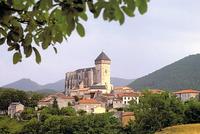 I like the Pyrenees, particularly the foothills. Very green hills and valleys, with the mountains rising up into the clouds further back. Yesterday we visited St Bertrand-de-Comminges, which is a village in the foothills. Today just a small sleepy village. I don't think I even saw any stores. But it is obviously a well-preserved fortified mideaval village on a hilltop. And on top of the hill you find a large cathedral, which obviously indicates that it has been an important place in the past. A great view from there as well. Eagles were hovering over the green valleys. The main parts of Cathedrale Sainte Marie were built in the 11th century by Bishop Bertrand, a cousin of Count Raymond IV of Toulouse, whom I happen to be reading a book about. The church is full of somewhat strange and humorous wood carvings. Lots of pagan influences, The Green Man, mermaids and monkeys, etc. And a magnificent 500 year old organ that is still playable. Having lived in the U.S. for so long, it seems particularly strange and awe inspiring that stuff that's that old can still be standing around. I like the Pyrenees, particularly the foothills. Very green hills and valleys, with the mountains rising up into the clouds further back. Yesterday we visited St Bertrand-de-Comminges, which is a village in the foothills. Today just a small sleepy village. I don't think I even saw any stores. But it is obviously a well-preserved fortified mideaval village on a hilltop. And on top of the hill you find a large cathedral, which obviously indicates that it has been an important place in the past. A great view from there as well. Eagles were hovering over the green valleys. The main parts of Cathedrale Sainte Marie were built in the 11th century by Bishop Bertrand, a cousin of Count Raymond IV of Toulouse, whom I happen to be reading a book about. The church is full of somewhat strange and humorous wood carvings. Lots of pagan influences, The Green Man, mermaids and monkeys, etc. And a magnificent 500 year old organ that is still playable. Having lived in the U.S. for so long, it seems particularly strange and awe inspiring that stuff that's that old can still be standing around.
The town is much older, though. Previously, it was founded in 72 B.C. as the Roman town of Lugdunum Convenarum. It was ruled by Pompei, and grew to a city of 100,000 inhabitants. Lots of ruins have been found, like the amphitheatre and the forum. Seems like you can't dig anywhere without turning up old buildings. Even though the archaeologists can't get their hands on all of it. There's a new school right in the middle of the forum, and somebody's house in the middle of the arena. New stuff built on top of the old. Supposedly archaelogists rent fields from farmers one by one, for a year at a time, dig up what they can find, and turn it back into a field afterwards.
[ History | 2004-06-20 09:00 | | PermaLink ] More >
|
|
| Wednesday, June 9, 2004 |  |
|
|
|
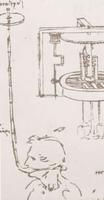 Via Julian Elve, the Notebooks of Leonardo da Vinci. Seems to be a successive series of notes he had made, which were translated into English at some point, and annotated by various scholars. And it is turned into an online book at Project Gutenberg. And the new thing is then that somebody turned it into an RSS feed, providing one piece per day. What I find interesting about that is that Leonardo's multi-talented renaissance genius is in many ways similar to what many bloggers are doing nowadays. You're interested in Many Things and feel free to jump around and study one thing or another. Thoughts, designs, personal explorations, poetry, or whatever. Here's Leonardo's post for today: Via Julian Elve, the Notebooks of Leonardo da Vinci. Seems to be a successive series of notes he had made, which were translated into English at some point, and annotated by various scholars. And it is turned into an online book at Project Gutenberg. And the new thing is then that somebody turned it into an RSS feed, providing one piece per day. What I find interesting about that is that Leonardo's multi-talented renaissance genius is in many ways similar to what many bloggers are doing nowadays. You're interested in Many Things and feel free to jump around and study one thing or another. Thoughts, designs, personal explorations, poetry, or whatever. Here's Leonardo's post for today:How by a certain machine many may stay some time under water. And how and wherefore I do not describe my method of remaining under water and how long I can remain without eating. And I do not publish nor divulge these, by reason of the evil nature of men, who would use them for assassinations at the bottom of the sea by destroying ships, and sinking them, together with the men in them. Nevertheless I will impart others, which are not dangerous because the mouth of the tube through which you breathe is above the water, supported on air sacks or cork. After the information overload has made us all drown in information, forced to specialize in very narrow fields, blogging is an example of a trend that appears to allow us again to act like renaissance people, having something to say about any subject.
[ History | 2004-06-09 06:00 | 0 comments | PermaLink ]
|
|
| Tuesday, February 17, 2004 |  |
|
|
|
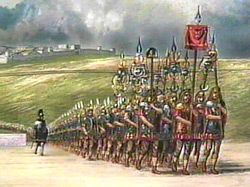 Johan Galtung is a professor of peace studies and a very studied man. He's written many big picture papers with lots of historic analysis about peace and war and the decline and fall of empires. Of most current interest might be "On the Coming Decline and Johan Galtung is a professor of peace studies and a very studied man. He's written many big picture papers with lots of historic analysis about peace and war and the decline and fall of empires. Of most current interest might be "On the Coming Decline and
Fall of the US Empire". Or, for a more historical comparison, read "The Decline and Fall of Empires", written for the United Nations Research Institute on Development in 1996, where he analyses and compares the decline and fall of 9 past empires, and, again, the United States, the only current empire. They all fail sooner or later, but not all for the same reasons, even though there seems to be some common factors. For most empires their decline generally come about from a lack of balance, a foundation of endless expansion and exploitation, pissing off a lot of people in the periphery, who are the ones being exploited, and a certain laziness that develops in the materially nonproductive elite in the center, where it becomes easier to buy or steal things from somebody else somewhere else than to bother to produce it oneself. And a falling apart of infrastructure, because it wasn't designed to be sustainable, and because those who designed the parts that worked no longer cared, or no longer were around. Anyway, here's a bit of a moral and a somewhat positive twist in the form of a metaphor of rats and ships:"These are ten stories of sinking ships, and ships usually harbor rats known to leave sinking ships. But who are the rats, and what do they do after leaving the sinking ship? They probably do not leave to drown, but possibly to find a new ship and a new life?
The immediate answer would be to find a new ship, although some rats may prefer dignified suicide to a life in the ruins of their own creation. There are exceptions like the captain of the sinking ship, the last one to leave even at the risk of joining the ship on its way down. Like ship captain, like captain of the state ship, the head of state. In principle. But in fact he often prefers escape and ends up as a monarch in exile, unable to find new ships. Better a life in faded splendor than death or suicide.
But we are thinking of more dynamic rats, not of aristoc-rats or bureauc-rats, but of creative clergy and intellectual ratss, and indeed entrepreneurial merchant rats. Each imperial decline creates its exodus and its diaspora. The question is, what kind of talent left, and where did they go? Regardless of the answer, this is clearly an illustration of Buddhist rebirth rather than Hindu reincarnation, let alone Christian eternal life.
The system does not reincarnate with many of its original features intact. By dying the system liberates creative energy, in the form of a diaspora which then starts working somewhere else. The obvious prognosis would be [1] given reasonable conditions they will probably succeed, [2] if or when there is no success they will probably leave the new sinking ship. Once a rat always a rat.
A major importer of rats leaving European sinking ships has been the USA. But the USA may also one day become a net exporter if the decline in mini-study 10 broadens and deepens further.
What people can do, countries may also do. Societies are to a large extent center-periphery systems with the center defining the problems and how to solve them, and the periphery doing the menial tasks of implementing the decisions. In the same vein, the World is to a large extent a Center-Periphery system, with the Center deciding what to do, giving minor roles to the Periphery countries, e.g., as defined by Ricardo's comparative advantages "theory", or ideology rather, of international trade.
But what happens if the center of society, or the Center of the world, declines? The social periphery may decide to leave, and vast caravans, trains of people, migrants in search of work and more promising conditions elsewhere will accompany the decline. The center minority may try to keep the migration within bonds, by sheer force or by the Toynbee formula, responding creatively to the crisis challenge by initiating new departures to convince the majority that they are still in command of the situation. Maybe they have three chances. After that, the periphery leaves, if not physically by migrating, then spiritually through lost allegiance.
Satellite client countries in the Periphery may do the same. They watch for the signs, and may decide to turn from a former Center to a new Center, like Eastern Europe from the Soviet Union to the EU and the USA. Malaysia, Australia and New Zealand, parts of the UK Center-Periphery system may look to Japan for new roles. Norway changed her allegiance from the USA (before that the UK, before that Sweden, before that Denmark) to the European Union. The latter seem better at practicing Toynbee. One Center elite may not be able to convince its Periphery, but by pooling together they may come up with a more attractive formula, like the Yaoundé-Lomé system for the African-Caribbean-Pacific countries.
Looking at the list of cases it is obvious that there are some genealogies at work. A major function of a dying system is to leave the scene, providing a niche of new economic opportunities to others. Brutal, but "such is life". "Decline and fall" is only one half of the story. The other half are the new ships, boarded or not by old, partly recycled, rats.
And thus it was that West Rome yielded to Franks and Gauls, and in the longer run to the Carolingians. Two centuries after the fall the Umayyad Arab empire of Damascus, defeated by the Abassids of Baghdad, changed the gap in Spain into the Caliphate of Córdoba (712). A dying Byzants had to yield to the triumphant Ottomans, and Spain to the Italian (and Low Countries) city-states and to the UK. The Ottomans had to yield to Russia, and to the Habsburgs and UK/France. And UK and Russia's successor, the Soviet Empire, had to yield to the USA. And to whom will ultimately the USA be yielding? To an expanded EU, to an East Asian Community, or both?
China has her own logic. The Ch'ing dynasty did not yield to any other country (except, for a short while to UK/France and some others), but to the Kuomintang dynasty, which in turn had to yield to the Communist dynasty; in both cases for much more than economic reasons narrowly defined. Precisely for this reason China has to be conceived of as a diachronic chain of dynasties rather than as a synchronic system of competitors, struggling over the same space.
This serves to relativize the concepts of decline and fall. A human being falls ill and dies, the family or somebody else fills the space. Societies also have families, inside their territory, or outside. None has a claim on eternal life. The death cause is interesting among other reasons to know whether euthanasia and midwifery would be the solution." Or maybe you can freeze the old empire cryogenically and thaw it up and look at it once in a while. Anyway, a key point is that the creative, positive life forces move on. Nothing oppressive can last forever, because it usually doesn't work very well. If the oppressed get bored with the game and refuse to play along, the picture sometimes transforms really quickly. But most empires leave some kind of positive legacy behind, of culture and ideals that might survive for a long time, even if the reality might have been brutal and unsustainable.
[ History | 2004-02-17 22:16 | | PermaLink ] More >
|
|
| Monday, January 12, 2004 |  |
|
|
|
 Here's another history lesson, from an article at Common Dreams, "How Will Bush Deal With the Deficits? Connecting the Dots to Iraq" by Robert Freeman. It is about how George W. Bush's government turned a budget surplus towards a now rapidly growing number of trillions of dollars of debt, with no plan for dealing with it in sight. No country has ever been this much bankrupt, but it is nevertheless interesting to look at how others historically have dealt with such situations. Here's another history lesson, from an article at Common Dreams, "How Will Bush Deal With the Deficits? Connecting the Dots to Iraq" by Robert Freeman. It is about how George W. Bush's government turned a budget surplus towards a now rapidly growing number of trillions of dollars of debt, with no plan for dealing with it in sight. No country has ever been this much bankrupt, but it is nevertheless interesting to look at how others historically have dealt with such situations.How, then, does a nation deal with debts that so greatly outrun its ability to pay? There are basically only five strategies. All are unappealing. Most are calamitous.
The most difficult strategy is, not surprisingly, the honest one: raise taxes and pay your bills. This is what King George III did following the Seven Years War with France in 1763. England had quadrupled its national debt in fighting the War and needed money to pay it off. It turned to the richest people in the realm, the Colonists, and began taxing paper, glass, paint, lead, and, of course, tea. The result, as we know, was the American Revolution.
It was the same strategy-raising taxes on the rich-that Louis XVI attempted in 1789. The French national debt had grown 10 fold under the pharoic opulence of Louis's grandfather, Louis XIV. Louis called the nobility and the clergy together and told them they would have to ante up. They, after all, had been exempted from taxes by Louis XIV in order to buy their complicity in his autocratic reign. Indignant, they refused to pay, precipitating the French Revolution, the most explosive upheaval to established government in the last thousand years.
A second strategy to deal with excessive debts is simply to print money. This is what Weimar Germany did to address the crushing debt imposed by the vengeful Treaty of Versailles. Before it was over the government had inflated the money supply by over a trillion times, leading some to comment that it was a waste of ink to put it onto paper worth so much less than the ink itself. The German middle class, whose assets were held at fixed amounts in government pensions, was destroyed. The collapse gave direct rise to Adolph Hitler.
A third strategy for dealing with onerous national debt is to sell off national assets. This is one of the first strategies the IMF imposes on third world countries that have gotten behind in their payments to western banks. Government-run industries, from telecommunications to water systems, are "privatized" and the country's natural resources are sold off to the highest foreign bidder. This is what Great Britain was forced to do in the aftermath or World War II.
Two world wars in only 30 years had ravaged the British economy and the pound sterling. Facing collapse at home (and revolution abroad), the government surrendered almost all of its colonies, from India and Pakistan to Nigeria, South Africa, Zambia and Zimbabwe. These had been among the greatest wealth-producing properties of modern times, the ones that had made the British Empire what it was. Their loss left Britain a second-rate power with only misty memories of its once imperial greatness.
A fourth strategy for dealing with excessive debt is to repudiate it. This was used for centuries in the early days of the modern world and was revived two years ago by Argentina which brazenly refused to pay some $110 billion in debts it had accumulated over prior decades. More ominously, it was this strategy that was used by the Bolsheviks after they took power in the Russian Revolution.
The new communist government refused to be bound by the debts of the overthrown Romanovs. But the French had loaned heavily to the Russian government for decades before World War I and now were left in a lurch. A cascading series of defaults from one bank to another caused a liquidity crisis on the continent, ultimately setting off the Great Depression.
Finally, there is plunder. When a nation's debt load becomes so huge it cannot plausibly reassure creditors regarding repayment, it must seek some source of wealth, any source, to keep the borrowed money flowing. This, naked predation, is what kept the Roman Empire alive for the last two hundred years of its existence. It is the strategy adopted by the Spanish Empire-silver and gold from America-and which eventually destroyed the vitality of its own merchant and civil servant classes.
Which, then, of the five above strategies will the U.S. adopt to deal with its exploding debt problem?
The author concludes, quite reasonably, I think, that Bush's answer will be a combination of solutions 3, 4 and 5. Sell off big chunks of assets to private interests, negate the responsibility for covering future social security, and go and plunder resources in other countries. Not pretty, but one might possibly keep it going for a while before anybody notices. At least until somebody else becomes president, who can then be blamed for it.
[ History | 2004-01-12 16:50 | | PermaLink ] More >
|
|
|
|
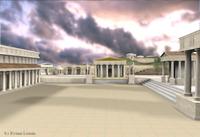 George Dafermos wrote a large and very impressive document Blogging the Market - How Weblogs are turning corporate machines into real conversations. It is a deep overview of how weblogs relate to, integrate with, and change how business works, and, well, why it is a good thing. And I'm not done reading it, so I'll return to it. But in part George has some excellent historic overviews. Like, this description of the Agora in ancient Athens is well worth repeating. George Dafermos wrote a large and very impressive document Blogging the Market - How Weblogs are turning corporate machines into real conversations. It is a deep overview of how weblogs relate to, integrate with, and change how business works, and, well, why it is a good thing. And I'm not done reading it, so I'll return to it. But in part George has some excellent historic overviews. Like, this description of the Agora in ancient Athens is well worth repeating.In the city-state of Athens, about 3,000 years ago, Athenian citizens used to meet regularly at the “town centre” to announce projects, discuss politics and military affairs and decide on matters of common interest. What was so peculiar about this congregation – that came to be known as ‘agora’ – is that all Athenian citizens had the right to speak their own mind about almost anything and address their fellow citizens and when a decision had to be made, no one’s vote mattered more than someone else’s. And everything took place out in the open. No single Athenian was privileged in terms of public exposure and all opinions voiced at the agora were judged against their own merit. The ability to speak, raise objections, comment and criticise was equally distributed among all attendants and power to decide on the action to be taken based on what was previously debated was also equally distributed. Some embraced their fellow citizens’ ideas, and joined a civic coalition to take immediate action provided of course that they managed to convince the majority while others detached themselves emotionally from these very same ideas and went on to counter argue and oppose them. Conflict, enthusiasm, dispute and all sorts of verbal demonstrations of human emotions and feelings were evident and encouraged. Legendary war campaigns, marches to the battlefield and critical community issues related to, say, education, sports or arts, were decided in this way rather than at the headquarters of the army general or at the palace of the ruling king (besides, there was no king). And that is what Democracy means in Greek: the public holds the power reigns. However, the organisation of the agora conveyed also something else: that power shifted to where knowledge resided. Athenians were empowered by the abstract, yet real social infrastructure of the agora to publicly demonstrate their knowledge by means of articulating arguments in favour or against of certain propositions and on these premises, to gain the respect, the approval and the support of everyone engaged in the conversation. Yet it is striking how distant this archaic “town centre” looks from the one we are familiar with. Time went by and approximately 2,150 years ago ancient Greek forces were outperformed by the Roman army in the battlefield, and Athens was eventually taken over by the Roman Empire. The Athenian democracy and agora did not ever recover. Never again in human history had people had this staggering ability to collectively make decisions and collectively implement them.
There's a lot more, so read for yourself. But just be aware that there's a lot of people looking for how we might establish something like the Athenian Agora today on the Internet. And weblogs might possibly be one of the key pieces.
[ History | 2004-01-12 16:23 | | PermaLink ] More >
|
|
| Friday, December 12, 2003 |  |
|
|
|
 The area of Toulouse we live in is called Arènes. We didn't think much about why, other than that the local metro station is also called Arènes, and it and the high school next to it are sort of shaped in an arena motif. The area of Toulouse we live in is called Arènes. We didn't think much about why, other than that the local metro station is also called Arènes, and it and the high school next to it are sort of shaped in an arena motif.
So I just now realize that it was because, quite recently, it was the site of a large bullfighting arena. From 1953-1976 this was Arènes du Soleil d'Or, one of the largest bullfighting arenas there has been in France, with room for 14,000 people. Famous torreadors like Paco Camino and El Cordobes have busied themselves fighting bulls to the death (the bull's) there.
I'm not sure I like bullfighting at all. But nowadays I believe it is mainly done in a non-lethal format the places it still happens in France. And this arena was torn down in 1990 to give way for the school and train station that is there now.
[ History | 2003-12-12 05:01 | | PermaLink ] More >
|
|
| Monday, December 8, 2003 |  |
|
|
|
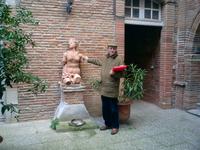 Americans in Toulouse are frequently arranging these historical walking tours lead by Gilbert. I've been on a few and it is is always interesting, even if it is on the local cemetary, or just looking at some old houses. Gilbert is a historian who knows his stuff, like the dates and names of apparently everything and everyone who was reasonably important within the last 1000 years or so in Toulouse. Where most people just walk down the street without thinking much about it, he seems to have a lot to say about every other house. Here he dragged us into a backyard of a house where a well-known manufacturer of statues was living. The morning was spent in the St.Cyprien quarter, close to where we live. Since it is on the left bank of the river, away from the rest of the city, that is where they first placed a hospital, so they could drag people over there who were suffering from the plague. And it was cheap land for an assortment of different monasteries and convents. Americans in Toulouse are frequently arranging these historical walking tours lead by Gilbert. I've been on a few and it is is always interesting, even if it is on the local cemetary, or just looking at some old houses. Gilbert is a historian who knows his stuff, like the dates and names of apparently everything and everyone who was reasonably important within the last 1000 years or so in Toulouse. Where most people just walk down the street without thinking much about it, he seems to have a lot to say about every other house. Here he dragged us into a backyard of a house where a well-known manufacturer of statues was living. The morning was spent in the St.Cyprien quarter, close to where we live. Since it is on the left bank of the river, away from the rest of the city, that is where they first placed a hospital, so they could drag people over there who were suffering from the plague. And it was cheap land for an assortment of different monasteries and convents.
[ History | 2003-12-08 07:41 | | PermaLink ] More >
|
|
| Saturday, November 1, 2003 |  |
|
|
|
 ABC TV plans a documentary looking into the possibility that Jesus had a wife. Should hardly be a news item, but apparently that is something that causes controversy. The show is based on The Da Vinci Code, a novel I haven't read, but which is based on lots of research found in other places. Like, I've read Holy Blood, Holy Grail. Which in part presents an excellent case for the story that Jesus and Mary Magdalene had descendants and that there's a lot of intrigue around secret groups of people carrying on and protecting their blood line. Anyway, as to the Da Vinci thing, look at the famous "Last Supper" picture. As Michael Rivero says: ABC TV plans a documentary looking into the possibility that Jesus had a wife. Should hardly be a news item, but apparently that is something that causes controversy. The show is based on The Da Vinci Code, a novel I haven't read, but which is based on lots of research found in other places. Like, I've read Holy Blood, Holy Grail. Which in part presents an excellent case for the story that Jesus and Mary Magdalene had descendants and that there's a lot of intrigue around secret groups of people carrying on and protecting their blood line. Anyway, as to the Da Vinci thing, look at the famous "Last Supper" picture. As Michael Rivero says:"That's a woman sitting next to Jesus, occupying the traditional position of a wife. Under Judaic laws of the time, Jesus could not be a Rabbi unless he were married. But Jesus marriage and his children are the secret Christianity does not want you to know, because the early Christian church leadership was based on the concept of apostolic descent, which only works if Jesus died without heirs. In the 1200s, the Catholic church, in order to consolidate power, undertook to erase from the world the descendants of the historical Jesus, and all public record that they had ever existed. In the process, 1/2 the population of Southern France was murdered." I don't know if it was exactly half, but it was pretty bad. And there we're talking here about the Albigensian Crusade in which the catholic church wiped out the Cathars and carried out a general genocide. "Kill them all, God will recognize His own." Anyway, a number of the trails of Jesus and Mary Magdalene seem to lead here, Southern France, the Languedoc area. And the Cathars happened to have their very own idea of what to believe in. Dan Sewell Ward says:"What did the people of the Languedoc do to deserve such a crusade? The Languedoc practiced a civilized, easy-going religious tolerance, much like Byzantium. In contrast to the fanatical zeal that characterized other parts of Europe, the Languedoc was a place where learning and philosophy flourished, poetry and courtly love were extolled, and Greek, Arabic and Hebrew were enthusiastically studied. Schools devoted to the Kaballah -- aka, Ha Qabala, the ancient exoteric tradition of Judaism -- thrived.
The key problem, from Rome's point of view, was that the Cathars in 1200 constituted a heresy which could conceivably displace Roman Catholicism as the dominant form of Christianity. In general the Cathars subscribed to a doctrine of reincarnation and to a recognition of the feminine principle in religion. Indeed, the preachers and teachers of Cathar congregations were of both sexes. At the same time the Cathars rejected the orthodox Catholic Church and denied the validity of all clerical hierarchies, all official and ordained intercessors between man and God.
At the core of this position lay an important Cathar tenet -- what the Church called the repudiation of "faith". In the place of "faith accepted at second hand", the Cathars insisted on direct and personal knowledge, a religious or mystical experience apprehended at the individual in a firsthand fashion. This experience has been called gnosis, from the Greek word for "knowledge", and for the Cathars it took precedence over all creeds and dogma. Given such emphasis on direct personal contact with God -- priests, bishops, and other clerical authorities became superfluous. Also, Popes. Oops." Sounds much preferable to me. No wonder they were massacred. But they aren't exactly gone. The spirit of the Cathars is quite alive today with the people who live here. It is an important memory and historical background for who people are, and just about everybody who's lived here for a while is ready to tell you the story, and you see books and magazines and TV shows everywhere about the Cathar heritage. And, I must admit, I find it rather intriguing myself.
[ History | 2003-11-01 18:11 | | PermaLink ] More >
|
|
| Thursday, September 4, 2003 |  |
|
|
|
 This region contains much history and many ancient mysteries and legends and interesting places and stories. This region contains much history and many ancient mysteries and legends and interesting places and stories.
The Gold of Tolosa is one of the good stories.
Toulouse first appears in the history books around 24 centuries ago when the Celtic tribe Volcae Tectosages settled in the Garonne valley and called their main city "Tolosa".
In the 3rd century B.C. Celtic armies had been attacking Greece. It is a longer story, but affairs were a bit messy, and it was a tempting target. Battles were fierce but ultimately the main Celtic force, lead by Brennos and Acichorios in 279BC more or less defeated the army of the combined Greek city-states at Thermopylai. The battles had however been very bloody, losses considerable, so instead of trying to push any further, they decided to just go raid the temple of Delphi, where immense riches had been collected for more than a thousand years, and make their way home. And despite obstacles and opposition, the Celtic force apparently managed to leave as quickly as they had appeared, with most of the treasure.
All signs point towards that the greater part of this treasure ended up being consecrated by the Cimbrian Druids to their own gods, and that it was hidden in a sacred well in the main temple in Tolosa. Which happened to be located approximately in the spot where today the Saint-Sernin Basilica stands in Toulouse.
There the treasure stayed for many years.
But Tolosa was a wealthy and flourishing city already then, and was located in a strategically convenient place, so it was only a matter of time before the Romans started becoming interested in it.
Consul Q. Servilius Caepio plundered the town and the temple in B.C. 106 with a large army. And he dragged off the treasure from the well, planning to take it to Rome.
However, they didn't get far. Cimbrian and Teuton armies engaged them and wiped them out. Caepio was defeated and 112,000 Romans and allies were left dead on the field.
And the treasure vanished again mysteriously. Official history doesn't have anything to say about what happened to it.
Nostradamus thinks it was miraculously restored to a good hiding place back in Toulouse, to be re-discovered at a later date. "In Toulouse, not far from Beluzer making a deep pit a palace of spectacle, the treasure found will come to vex everyone in two places and near the Basacle." Sounds a lot to me like a metro station on the new B line they're building, which happens to pass right by St.Sernin Basilica. Often, when they dig new subway tunnels here in Toulouse, they run into ancient ruins. So, lots of things might come to light. I might even find the treasure in my basement some day, who knows.
Other people speculate that it might be the mysterious treasure that a priest seems to have found in the 1890s in Rennes-le-Chateau, rather than parts of a treasure the Visigoths took from the temple of Jerusalem, which is what is normally conjectured. And Rennes-le-Chateau is after all not far from where the Caepio was stopped in his tracks on the way towards Rome, so it makes some sense as a possibility.
Based on this part of history and the fate of Caepio and his army, a Latin saying developed, "aurum Tolosanum habet" ("He has got the gold of Tolosa"), which essentially came to mean "His ill-gotten wealth will do him no good". Caepio became the poster boy for bad karma acquired from laying your clammy hands on treasures that aren't yours, instead of doing your job. So, I guess I've better concentrate on my own sources of wealth.
If you are in the mood, somebody even made a game "The Gold of Tolosa", loosely based on this story.
[ History | 2003-09-04 10:37 | | PermaLink ] More >
|
|
| Tuesday, May 6, 2003 |  |
|
|
|
 University professor Jared Diamond talks about why societies sometimes make decisions that result in their collapse, or why they fail to make decisions that would have rectified things. University professor Jared Diamond talks about why societies sometimes make decisions that result in their collapse, or why they fail to make decisions that would have rectified things.What I'm going to suggest is a road map of factors in failures of group decision making. I'll divide the answers into a sequence of four somewhat fuzzily delineated categories. First of all, a group may fail to anticipate a problem before the problem actually arrives. Secondly, when the problem arrives, the group may fail to perceive the problem. Then, after they perceive the problem, they may fail even to try to solve the problem. Finally, they may try to solve it but may fail in their attempts to do so. While all this talking about reasons for failure and collapses of society may seem pessimistic, the flip side is optimistic: namely, successful decision-making. Perhaps if we understand the reasons why groups make bad decisions, we can use that knowledge as a check list to help groups make good decisions. There's an interesting little video on the site of him lecturing about it as well. Why is that kind of clarity and simplicity only found scattered among people who lecture and write books? I mean, why aren't people who ask such questions part of running our societies?
Some of what he talks about is environmental mis-management. For example, the people on Easter Island cut down all the forests on their rather small island, to build canoes, roll around statues, and whatever they were doing. Thus they killed the resources their lives depended on, and they started dying off, turning to canibalism, etc. until they had turned themselves into a faint shadown of their former glory. A question is: What did the Easter Islanders think as they were cutting down the last tree? That wasn't any subtle mistake. Did they really not notice? How can we avoid making that kind of mistakes? Or, since we probably already are - how can we truly comprehend that as a society?
[ History | 2003-05-06 23:59 | | PermaLink ] More >
|
|
| Wednesday, February 26, 2003 |  |
|
|
|
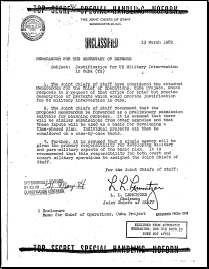 From IncuBLOGula: From IncuBLOGula:CODENAMED Operation Northwoods, the plan, which had the written approval of the Chairman and every member of the Joint Chiefs of Staff, called for innocent people to be shot on American streets; for boats carrying refugees fleeing Cuba to be sunk on the high seas; for a wave of violent terrorism to be launched in Washington, D.C., Miami, and elsewhere. People would be framed for bombings they did not commit; planes would be hijacked. Using phony evidence, all of it would be blamed on Castro, thus giving [Lyman L] Lemnitzer* (right) and his cabal the excuse, as well as the public and international backing, they needed to launch their war. That was in 1962, and the plan wasn't actually carried out at the time, possibly due to a fear of Russian retaliation. See the original document, obtained by the Freedom of Information Act from the National Security Archive. Do you think projects like that are more likely or less likely today under president Bush than they were under president Kennedy?
[ History | 2003-02-26 18:09 | | PermaLink ] More >
|
|
| Monday, January 27, 2003 |  |
|
|
|
The Economist has an excellent article giving a balanced overview of the Israeli/Palestinian conflict, titled "It should have been so simple". Rather rare to see a well-balanced piece like that in a U.S. magazine. [Oops, I later realize it is a primarily U.K. magazine, but still]. It suggests the obvious, that the parties need to sensibly sort out how to share the land they reside in. And various road maps have been suggested along the way."But a map is not much good unless the Israelis and Palestinians can be prevailed upon to follow it. And this, gloomsters say, will not happen so long as the two old men, Mr Sharon and Mr Arafat, remain where they are. Mr Sharon is a disaster because he does not accept the central land-for-peace equation; Mr Arafat because he has lost control and drifts with the tide of events."
[ History | 2003-01-27 23:59 | | PermaLink ] More >
|
|
Page: 1 2 Older stories >> |

 First, a little piece about patterns, which I noticed quite randomly in an article about Ancient Chinese Sex Advice:
First, a little piece about patterns, which I noticed quite randomly in an article about Ancient Chinese Sex Advice: CNN:
CNN:
 A little history lesson from Ben Hammersley:
A little history lesson from Ben Hammersley: Timothy Wilken:
Timothy Wilken: I like the Pyrenees, particularly the foothills. Very green hills and valleys, with the mountains rising up into the clouds further back. Yesterday we visited St Bertrand-de-Comminges, which is a village in the foothills. Today just a small sleepy village. I don't think I even saw any stores. But it is obviously a well-preserved fortified mideaval village on a hilltop. And on top of the hill you find a large cathedral, which obviously indicates that it has been an important place in the past. A great view from there as well. Eagles were hovering over the green valleys. The main parts of Cathedrale Sainte Marie were built in the 11th century by Bishop Bertrand, a cousin of Count Raymond IV of Toulouse, whom I happen to be reading a book about. The church is full of somewhat strange and humorous wood carvings. Lots of pagan influences, The Green Man, mermaids and monkeys, etc. And a magnificent 500 year old organ that is still playable. Having lived in the U.S. for so long, it seems particularly strange and awe inspiring that stuff that's that old can still be standing around.
I like the Pyrenees, particularly the foothills. Very green hills and valleys, with the mountains rising up into the clouds further back. Yesterday we visited St Bertrand-de-Comminges, which is a village in the foothills. Today just a small sleepy village. I don't think I even saw any stores. But it is obviously a well-preserved fortified mideaval village on a hilltop. And on top of the hill you find a large cathedral, which obviously indicates that it has been an important place in the past. A great view from there as well. Eagles were hovering over the green valleys. The main parts of Cathedrale Sainte Marie were built in the 11th century by Bishop Bertrand, a cousin of Count Raymond IV of Toulouse, whom I happen to be reading a book about. The church is full of somewhat strange and humorous wood carvings. Lots of pagan influences, The Green Man, mermaids and monkeys, etc. And a magnificent 500 year old organ that is still playable. Having lived in the U.S. for so long, it seems particularly strange and awe inspiring that stuff that's that old can still be standing around.
 Via Julian Elve, the Notebooks of Leonardo da Vinci. Seems to be a successive series of notes he had made, which were translated into English at some point, and annotated by various scholars. And it is turned into an online book at Project Gutenberg. And the new thing is then that somebody turned it into an RSS feed, providing one piece per day. What I find interesting about that is that Leonardo's multi-talented renaissance genius is in many ways similar to what many bloggers are doing nowadays. You're interested in Many Things and feel free to jump around and study one thing or another. Thoughts, designs, personal explorations, poetry, or whatever. Here's Leonardo's post for today:
Via Julian Elve, the Notebooks of Leonardo da Vinci. Seems to be a successive series of notes he had made, which were translated into English at some point, and annotated by various scholars. And it is turned into an online book at Project Gutenberg. And the new thing is then that somebody turned it into an RSS feed, providing one piece per day. What I find interesting about that is that Leonardo's multi-talented renaissance genius is in many ways similar to what many bloggers are doing nowadays. You're interested in Many Things and feel free to jump around and study one thing or another. Thoughts, designs, personal explorations, poetry, or whatever. Here's Leonardo's post for today: Johan Galtung is a professor of peace studies and a very studied man. He's written many big picture papers with lots of historic analysis about peace and war and the decline and fall of empires. Of most current interest might be "On the Coming Decline and
Johan Galtung is a professor of peace studies and a very studied man. He's written many big picture papers with lots of historic analysis about peace and war and the decline and fall of empires. Of most current interest might be "On the Coming Decline and
 Here's another history lesson, from an article at Common Dreams, "How Will Bush Deal With the Deficits? Connecting the Dots to Iraq" by Robert Freeman. It is about how George W. Bush's government turned a budget surplus towards a now rapidly growing number of trillions of dollars of debt, with no plan for dealing with it in sight. No country has ever been this much bankrupt, but it is nevertheless interesting to look at how others historically have dealt with such situations.
Here's another history lesson, from an article at Common Dreams, "How Will Bush Deal With the Deficits? Connecting the Dots to Iraq" by Robert Freeman. It is about how George W. Bush's government turned a budget surplus towards a now rapidly growing number of trillions of dollars of debt, with no plan for dealing with it in sight. No country has ever been this much bankrupt, but it is nevertheless interesting to look at how others historically have dealt with such situations. George Dafermos wrote a large and very impressive document Blogging the Market - How Weblogs are turning corporate machines into real conversations. It is a deep overview of how weblogs relate to, integrate with, and change how business works, and, well, why it is a good thing. And I'm not done reading it, so I'll return to it. But in part George has some excellent historic overviews. Like, this description of the Agora in ancient Athens is well worth repeating.
George Dafermos wrote a large and very impressive document Blogging the Market - How Weblogs are turning corporate machines into real conversations. It is a deep overview of how weblogs relate to, integrate with, and change how business works, and, well, why it is a good thing. And I'm not done reading it, so I'll return to it. But in part George has some excellent historic overviews. Like, this description of the Agora in ancient Athens is well worth repeating. The area of Toulouse we live in is called Arènes. We didn't think much about why, other than that the local metro station is also called Arènes, and it and the high school next to it are sort of shaped in an arena motif.
The area of Toulouse we live in is called Arènes. We didn't think much about why, other than that the local metro station is also called Arènes, and it and the high school next to it are sort of shaped in an arena motif.
 Americans in Toulouse are frequently arranging these historical walking tours lead by Gilbert. I've been on a few and it is is always interesting, even if it is on the local cemetary, or just looking at some old houses. Gilbert is a historian who knows his stuff, like the dates and names of apparently everything and everyone who was reasonably important within the last 1000 years or so in Toulouse. Where most people just walk down the street without thinking much about it, he seems to have a lot to say about every other house. Here he dragged us into a backyard of a house where a well-known manufacturer of statues was living. The morning was spent in the St.Cyprien quarter, close to where we live. Since it is on the left bank of the river, away from the rest of the city, that is where they first placed a hospital, so they could drag people over there who were suffering from the plague. And it was cheap land for an assortment of different monasteries and convents.
Americans in Toulouse are frequently arranging these historical walking tours lead by Gilbert. I've been on a few and it is is always interesting, even if it is on the local cemetary, or just looking at some old houses. Gilbert is a historian who knows his stuff, like the dates and names of apparently everything and everyone who was reasonably important within the last 1000 years or so in Toulouse. Where most people just walk down the street without thinking much about it, he seems to have a lot to say about every other house. Here he dragged us into a backyard of a house where a well-known manufacturer of statues was living. The morning was spent in the St.Cyprien quarter, close to where we live. Since it is on the left bank of the river, away from the rest of the city, that is where they first placed a hospital, so they could drag people over there who were suffering from the plague. And it was cheap land for an assortment of different monasteries and convents. ABC TV plans a documentary looking into the possibility that Jesus had a wife. Should hardly be a news item, but apparently that is something that causes controversy. The show is based on The Da Vinci Code, a novel I haven't read, but which is based on lots of research found in other places. Like, I've read Holy Blood, Holy Grail. Which in part presents an excellent case for the story that Jesus and Mary Magdalene had descendants and that there's a lot of intrigue around secret groups of people carrying on and protecting their blood line. Anyway, as to the Da Vinci thing, look at the famous "Last Supper" picture. As Michael Rivero says:
ABC TV plans a documentary looking into the possibility that Jesus had a wife. Should hardly be a news item, but apparently that is something that causes controversy. The show is based on The Da Vinci Code, a novel I haven't read, but which is based on lots of research found in other places. Like, I've read Holy Blood, Holy Grail. Which in part presents an excellent case for the story that Jesus and Mary Magdalene had descendants and that there's a lot of intrigue around secret groups of people carrying on and protecting their blood line. Anyway, as to the Da Vinci thing, look at the famous "Last Supper" picture. As Michael Rivero says: This region contains much history and many ancient mysteries and legends and interesting places and stories.
This region contains much history and many ancient mysteries and legends and interesting places and stories.
 University professor Jared Diamond talks about why societies sometimes make decisions that result in their collapse, or why they fail to make decisions that would have rectified things.
University professor Jared Diamond talks about why societies sometimes make decisions that result in their collapse, or why they fail to make decisions that would have rectified things. From IncuBLOGula:
From IncuBLOGula: